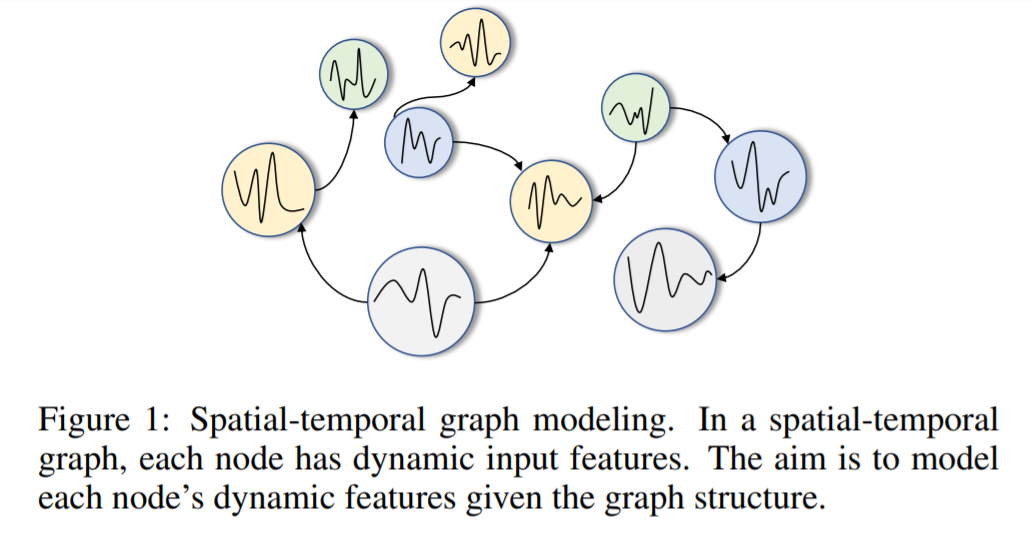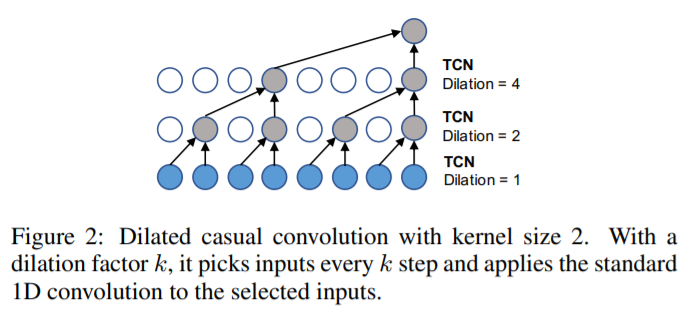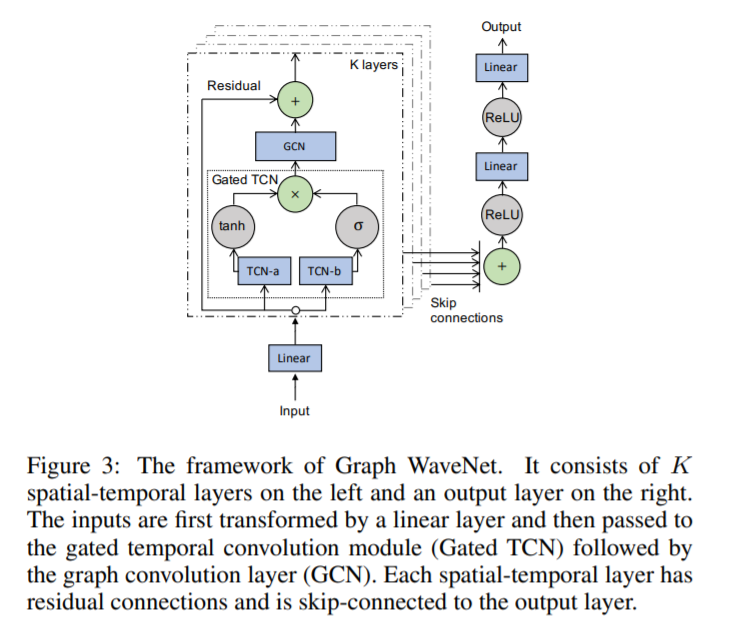Graph WaveNet for Deep Spatial-Temporal Graph Modeling
Contents
- Abstract
- Introduction
- Related Works
- GCN
- Spatial-temporal Graph Networks
- Methodology
- Problem Definition
- GCN layer
- TCN layer
- Framework of Graph WaveNet
0. Abstract
Spatial-temporal graph modeling : analyze..
- 1) spatial relations
- 2) temporal trends
Problem :
- 1) explicit graph structure “does not necessarily reflect the true dependency”
- 2) existing methods are ineffective to capture temporal trends
- RNNs, CNNs : can not capture LONG-range temporal sequences
Graph Wavenet
- (1) develop a novel adaptive dependency matrix
- (2) stacked dilated 1D conv ( able to handle very LONG sequences )
1. Introduction
Spatial-temporal graph modeling
-
aims to model the “dynamic node-level inputs”
by assuming “inter-dependency between nodes”
- ex ) traffic speed forecasting
- basic assumption :
- node’s future information is conditioned on..
- 1) its historical info
- 2) neighbors’ historical info
- node’s future information is conditioned on..
-
key point :
- how to capture SPATIAL and TEMPORAL dependencies

Recent works : 2 directions
- 1) integrate GCN into RNN
- 2) integrate GCN into CNN
Shortcomings of 2 approaches
-
1) assumes that “graph structure reflects genuine dependency”
\(\rightarrow\) not always the case
-
2) ineffective to learn temporal dependencies
Graph WaveNet
- address the 2 shortcomings
- 2 key points
- 1) self-adaptive adjacency matrix
- 2) stacked dilated causal convolutions
2. Related Works
(1) GCN
- building blocks for learning graph-structured data
- widely used in..
- node embedding / node classification / graph classification / link prediction / node clustering
- 2 main streams of GCN
- 1) Spectral-based approaches
- smooth a node’s input signals, using graph spectral filters
- 2) Spatial-based appraoches
- extract node’s high-level representation, by aggregating feature info from neighbors
- (usually) adjacency matrix is considered as prior & fixed throughout training
- 1) Spectral-based approaches
(2) Spatial-temporal Graph Networks
2 directions
- 1) RNN-based : inefficient for long sequences
- 2) CNN-based : efficient, but have to stack many layers
3. Methodology
Two building blocks of Graph WaveNet
- 1) GCN (Graph Convolutional Layer)
- 2) TCN (Temporal Convolutional Layer)
\(\rightarrow\) work together to capture the “spatial-temporal dependencies”
(1) Problem Definition
Notation
-
graph : \(G=(V, E)\)
-
adjacency matrix : \(\mathbf{A} \in \mathbf{R}^{N \times N}\)
-
( at each time step \(t\) )
dynamic feature of \(G\) : \(\mathbf{X}^{(t)} \in \mathbf{R}^{N \times D} .\) ( = graph signals )
Goal : \(\left[\mathbf{X}^{(t-S): t}, G\right] \stackrel{f}{\rightarrow} \mathbf{X}^{(t+1):(t+T)}\).
- given (1) graph \(G\) & (2) historical \(S\) step graph signals,
- predict next \(T\) step graph signals
(2) GCN layer
extract a node’s features, given structural information
Graph Convolution Layer : \(\mathbf{Z}=\tilde{\mathbf{A}} \mathbf{X} \mathbf{W}\)
- \(\tilde{\mathbf{A}} \in \mathbf{R}^{N \times N}\) : normalized adjacency matrix ( with self-loops )
- \(\mathbf{X} \in \mathbf{R}^{N \times D}\) : input signals
- \(\mathbf{Z} \in \mathbf{R}^{N \times M}\) : output
- \(\mathbf{W} \in \mathbf{R}^{D \times M}\) : model parameter matrix
Diffusion Convolution Layer : \(\mathbf{Z}=\sum_{k=0}^{K} \mathbf{P}^{k} \mathbf{X} \mathbf{W}_{\mathbf{k}}\)
- effective in “spatial-temporal modeling”
- modeled the diffusion process of graph signals with \(K\) finite steps
-
\(\mathbf{P}^{k}\) : the power series of the transition matrix
- ( if directed ) \(\mathbf{Z}=\sum_{k=0}^{K} \mathbf{P}_{f}^{k} \mathbf{X W}_{k 1}+\mathbf{P}_{b}^{k} \mathbf{X} \mathbf{W}_{k 2}\)
Self-adaptive Adjacency Matrix : \(\tilde{\mathbf{A}}_{a d p}\)
\(\tilde{\mathbf{A}}_{a d p}=\operatorname{Soft} \operatorname{Max}\left(\operatorname{ReLU}\left(\mathbf{E}_{1} \mathbf{E}_{2}^{T}\right)\right)\).
-
does not require any prior knowledge
-
let the model discover hidden spatial dependencies
-
Notation
-
\(\mathbf{E} 1\) : source node embedding
-
\(\mathbf{E} 2\) : target node embedding
( by multiplying both, derive the “spatial dependency weights between 2 nodes” )
-
-
this \(\tilde{\mathbf{A}}_{a d p}\) can be considered as “transition matrix” of hidden diffusion process
Proposal :
- (if graph structure : available)
- \[\mathbf{Z}=\sum_{k=0}^{K} \mathbf{P}_{f}^{k} \mathbf{X} \mathbf{W}_{k 1}+\mathbf{P}_{b}^{k} \mathbf{X} \mathbf{W}_{k 2}+\tilde{\mathbf{A}}_{a p t}^{k} \mathbf{X} \mathbf{W}_{k 3} .\]
- (if graph structure : unavailable)
- \(\mathbf{Z}=\sum_{k=0}^{K} \tilde{\mathbf{A}}_{a p t}^{k} \mathbf{X} \mathbf{W}_{k}\).
(3) TCN layer
adopt “dilated causal convolution”

Gated TCN
- simple version : \(\mathbf{h}=g\left(\boldsymbol{\Theta}_{1} \star \mathcal{X}+\mathbf{b}\right) \odot \sigma\left(\mathbf{\Theta}_{2} \star \mathcal{X}+\mathbf{c}\right)\).
- use this to learn “complex temporal dependencies”
(4) Framework of Graph WaveNet

